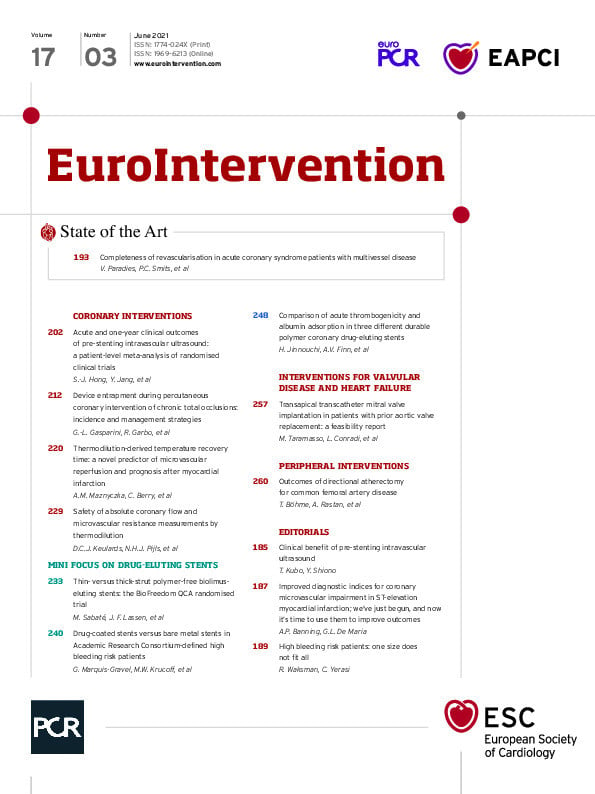Prompt reperfusion has improved the prognosis in patients with ST-elevation myocardial infarction (STEMI). However, there remains a relevant proportion of patients who still experience heart failure. This has implications for survival and quality of life and has a major impact on use and allocation of resources across healthcare systems.
Studies investigating opportunities to improve the emergency revascularisation procedure using additional or novel therapeutic strategies have generally yielded negative or neutral results. Whilst many factors might account for this, the strategy of using an “all-comers” approach, with its unintended bias towards preferential inclusion of lower-risk patients, has resulted in many carefully designed studies being underpowered. For this reason, a particular focus on methods/tools to improve risk stratification within the catheterisation laboratory seems appropriate, with the aim of facilitating early triage and selection for novel alternative/additional therapies. This approach appears to be crucial to allow the evolution of primary percutaneous coronary intervention (PCI) whilst minimising extra cost, procedural time and risk.
Coronary microvascular injury has a fundamental pathophysiological role in defining the extent of myocardial damage. It represents not only a therapeutic target, but also a measurable marker of high clinical risk. Using an objective measure of coronary microvascular injury/dysfunction would overcome the semi-quantitative nature and the low reproducibility of earlier indices of myocardial reperfusion such as Thrombolysis In Myocardial Infarction (TIMI) flow or myocardial blush grade. Indices of coronary physiology, derived via either thermodilution techniques or Doppler guidewire, are an attractive solution. Thermodilution techniques appear to be easier to use and, more specifically, the index of microcirculatory resistance (IMR) is used increasingly to diagnose coronary microvascular dysfunction.
In patients with STEMI, an increased IMR has been associated with worse clinical prognosis1. It provides additional functional details about the coronary microvascular status in a complementary manner to the structural/anatomical insights offered by cardiac magnetic resonance imaging (cMRI), with patients with elevated IMR and microvascular obstruction (MVO) having the worst long-term prognosis2.
In this issue of EuroIntervention, Maznyczka et al validated the temperature recovery time (TRT), as a novel thermodilution-based index to define the presence of microvascular injury in STEMI3.
The authors demonstrate a discrete association with MVO and a predictive clinical value for major adverse cardiac events (MACE) at 30 days and five years. The rationale behind the development of TRT was to overcome a perceived operator-dependent feature of IMR, related mainly to the manual injection of room-temperature saline. This potential limitation appears to be addressed by TRT as it restricts the analysis to the “ascending” phase of the thermodilution curve.
We have previously shown that IMR can be used successfully to triage STEMI patients for recruitment to pilot trials of experimental therapies4. These new data encourage adding TRT to the list of the available parameters to assess microvascular function acutely, although more data and further external validation are necessary to understand whether and when TRT offers a real advantage over “conventional” IMR. Importantly, we welcome the renewed momentum and focus that this study brings, as it highlights the need to move towards a more personalised approach for treatment algorithms in STEMI. Regrettably, assessment of coronary microvascular function is not available in many catheterisation laboratories, and experience of IMR measurement in STEMI has been restricted to expert centres and enthusiasts. We have speculated that perhaps novel angiography-based indices, obtained through the application of computational flow dynamics to a three-dimensional model of the coronary tree, might resolve some of the issues relating to the use of the pressure wire5. This measurement, available within minutes at the catheterisation laboratory table, might overcome some of the logistic barriers to uptake. However, whilst we continue to improve diagnostics, it is increasingly apparent that we must now start shifting the focus from the “search for new indices” to the actual application of the ones that are available. Facilitating the design and subsequent recruitment to studies for testing alternative and additional therapies in STEMI is the real challenge. Novel and exciting potential therapies and devices are available, which might be applied to the correct cohort of patients by purpose-built consensual research/collaborations/networks. Perhaps careful collation of these elements will provide the next big step in individualising patient treatment regimes, and together improve observed outcomes for the STEMI patients at highest risk.
Conflict of interest statement
A.P. Banning reports receiving an unrestricted research grant from Boston Scientific and speaker and consultancy fees from Abbott, Boston Scientific, Philips and Miracor Medical SA. G.L. De Maria reports receiving research grants from Abbott and Miracor Medical SA and speaker fees from Miracor Medical SA.
Supplementary data
To read the full content of this article, please download the PDF.

